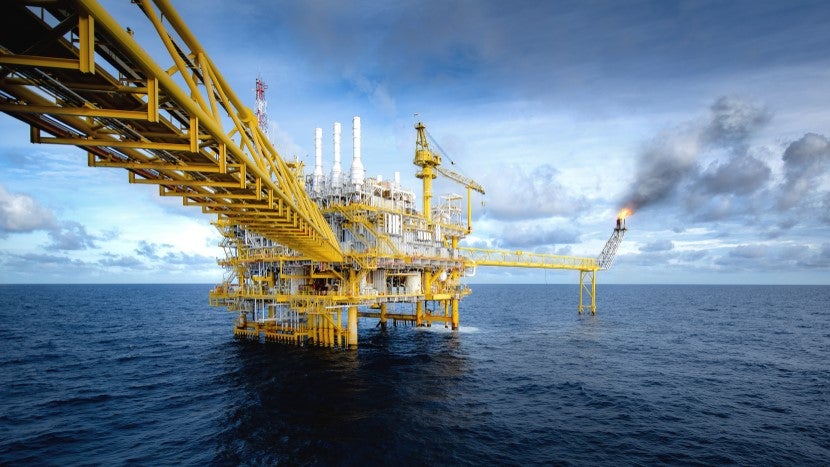
Trends evident across the oil and gas sector in 2023 demonstrate a volatile market that is in a period of global change as pressure builds on governments worldwide to move towards renewable energy sources.
Artificial Intelligence
In oil and gas, adoption of artificial intelligence (AI) was a prominent trend throughout 2023; the technology can be used to analyze data quickly and efficiently, helping to inform decisions. AI can help automate physical labor making sites safer and offering a particular advantage to risky offshore projects.
A recent report from GlobalData, Offshore Technology’s parent company, explains: “AI has emerged as one of the most promising technologies in digitizing the oil and gas industry. Like [for] the power industry, AI facilitates predictive maintenance models and operational streamlining. It also has specific applications in discovering, managing and selling new hydrocarbons. Introducing stability into the inherently volatile market can lead to better decision-making, reduced costs and increased efficiency.”
The report notes companies leading the use of AI in the integrated oil and gas sector, identifying Chevron, Ecopetrol, Petrobras, Reliance Industries, Repsol, Rosneft, Saudi Aramco, Shell and BP as names of note.
BP in particular has a history of investing in AI. The company partnered with Microsoft Azure as early as 2017, using Machine Learning (ML) to streamline drilling processes. In 2020, it collaborated with Bluware, using deep learning for subsurface data interpretation. More recently, in May 2023, Poweverse – an energy technology startup created by Lightsource BP – launched its AI-powered home energy management platform for domestic consumers.
GlobalData also identifies several laggards that are falling behind on realising AI’s potential. These include CNPC, MOL, ONGC, PKN Orlen and QatarEnergy.
How well do you really know your competitors?
Access the most comprehensive Company Profiles on the market, powered by GlobalData. Save hours of research. Gain competitive edge.

Thank you!
Your download email will arrive shortly
Not ready to buy yet? Download a free sample
We are confident about the unique quality of our Company Profiles. However, we want you to make the most beneficial decision for your business, so we offer a free sample that you can download by submitting the below form
By GlobalDataM&A deals
According to figures collected and analyzed by GlobalData, the oil and gas industry saw a total of 1,571 M&A deals in 2023.
The most financially significant deal in the sector was announced in October, when ExxonMobil agreed to acquire a 100% stake in Pioneer Natural Resources. Expected to be closed in June 2024, the deal has an equity value of $59.6bn and an enterprise value $64.5bn.
Also significant was the deal agreed by Chevron to acquire a 100% stake in Hess, which is engaged in the exploration and production of crude oil and natural gas in offshore Guyana. Agreed in October, the deal is worth $60bn, and will be completed in June 2024.
Hiring trends
Analysis of hiring trends in offshore oil and gas revealed the environment was a popular and increasingly important theme behind active roles, with 1,811 positions in January 2023, increasing to 2,203 in November, following a peak of 2,891 in June. Within these roles relating to the environment, chemical engineers, and electrical and electronic engineers were two of the most consistently popular roles.
However, jobs were down across the sector more broadly. Of all jobs tracked across all sectors, 6.5% were from the oil and gas industry in Q3 2023, down from 10.1% in Q3 2022. This corresponded with a significant increase in jobs in the power sector, which jumped from 0.4% of the job postings in Q3 2022 to 3.0% in Q3 2023.
In Q1 2023, the top oil and gas recruiters included Saudi Kayan Petrochemical, and John Wood Group. John Wood Group continued to lead in Q2, along with Halliburton and Valvoline, while in Q3, Marathon Petroleum, Baker Hughes and NOV were the biggest hirers.
Fluctuating oil and gas prices
The International Energy Agency's (IEA) most recent oil market report notes a significant downturn in market sentiment in November and December, when strong oil supply from non-OPEC+ countries coincided with slowing global oil demand growth. The result was that, by December, oil prices had dropped around $25/bbl from September to their lowest levels in six months. At the time of writing, Brent Crude was trading at $80.21/bbl, whilst WTI Crude Oil was trading $75.00.
Prior to this drop, the sector experienced high prices, prompted by August’s 13-month low in oil inventories. Specifically, the IEA reported that: “Non-OECD oil stocks fell by 20.8mb with the largest draw seen in China, while OECD inventories eased by 3.2 mb. In July, OECD industry stocks rose by 26.7mb to 2 814mb but remained 102.6mb below their five-year average.”
Meanwhile, in the gas sector, prices continued to experience volatility; since Russia’s invasion of Ukraine in February 2022, the market has experienced difficulties, despite the comparative balance offered by higher storage levels in Europe.
The IEA reports: “The supply side remained tight in the first three quarters of 2023, as the additional LNG supply (+11bcm) was insufficient to offset the steep decline in Russian piped gas deliveries to the European Union (-38bcm).” It notes that August 2023 saw the highest level of volatility (according to the European benchmark) since the invasion as strike risks in Australia and unplanned outages in Norway offered a gloomy near-term gas supply outlook.
Gas consumption more broadly is set to stagnate, as markets in Europe, the US and Asia-Pacific turn increasingly to renewable energy. The IEA expects Eurasia’s demand to stand only 2% above its 2021 level by 2026. Looking forward, market prices will be set by demand growth in Asian markets (particularly China), Africa and the Middle East, where Iran, Israel and Saudi Arabia are likely to expand gas-intensive industries.






